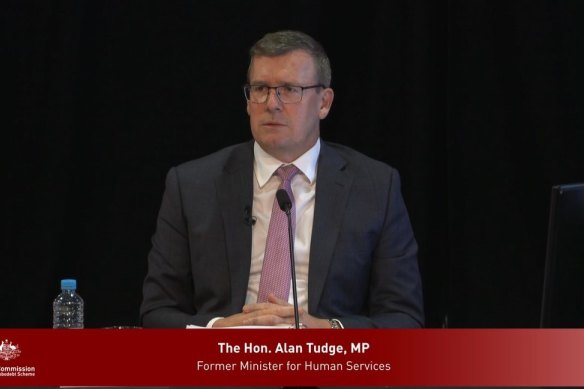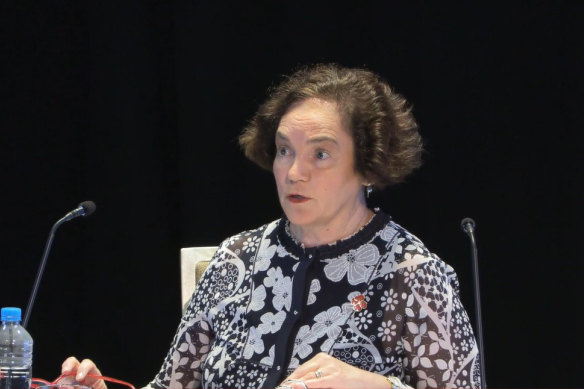What you need to know about the robo-debt royal commission

Save articles for later
Add articles to your saved list and come back to them any time.
Standing at nearly 1000 pages and with 57 recommendations, the final report of the robo-debt royal commission has now been published.
Here are some of the main takeaways – and some of the questions that remain after its release.
Robo-debt royal commissioner Catherine Holmes, SC, delivered her 990-page report to Governor-General David Hurley this morning.Credit: AAP
What the report said about the scheme
Royal commissioner Catherine Holmes, SC, said the scheme, which aimed to claw back $1.7 billion in allegedly overpaid welfare from recipients, was utterly mishandled from its conception to rollout.
Even when the scheme’s “unfairness, probable illegality and cruelty” came to light in early 2017, she said the government doubled down and attacked recipients who had complained through the media.
The scheme ended up recouping just $406.2 million, while costing the Commonwealth $971.4 million in implementation and administration and to wind it back. Overall, the scheme cost the government a net $565.2 million.
Former prime minister Scott Morrison allowed cabinet to be misled over robo-debt
Holmes found that Morrison, who was the social services minister behind the robo-debt scheme rollout in 2015, had allowed cabinet to be misled over the legality of the scheme.
The report found he didn’t follow up on an inconsistency in 2015 after a stated need for legislative change to implement the scheme disappeared from a policy document prepared by bureaucrats that he took to cabinet.
Holmes also found Morrison had misled the commission with some of his evidence. Morrison rejected the findings against him, saying they were “offensive and baseless”.
Former minister Alan Tudge engaged in ‘abuse of power’
The commission heard evidence that part of the government’s defence of the scheme included the release of personal information about some Centrelink customers to correct what were said to be inaccuracies in the media.
In her final report, Commissioner Holmes said Tudge had a significant amount of public power, but abused that power through using information about welfare recipients in the media “to distract from and discourage commentary about the scheme’s problems”.
“It was all the more reprehensible in view of the power imbalance between the minister and the cohort of people upon whom it would reasonably be expected to have the most impact, many of whom were vulnerable and dependent on the department, and its minister, for their livelihood,” the report said.
The commission found Tudge used his power “to distract from and discourage commentary” about robo-debt.
Tudge said he strongly rejected the Commission’s comments about the way he used the media and that he had abused his power.
“I reject that finding in the strongest term,” he said in a statement.
What it said about former minister Stuart Robert
Robert was briefly responsible for robo-debt in mid to late 2019. The scheme was shut down in November 2019 after the Commonwealth settled a test case and agreed to orders declaring that key parts of the scheme were unlawful.
The report rejected Robert’s claim that he acted to end the scheme, finding instead said former Department of Human Services secretary Renee Leon took the first steps to end robo-debt.
What it said about former department head Kathryn Campbell
Department of Human Services secretary Kathryn Campbell was criticised by the robo-debt royal commission for failing to act when confronted with information pointing to the unlawfulness of the debt recovery scheme.
“Ms Campbell had been responsible for a department that had established, implemented and maintained an unlawful program,” the report said.
Senior bureaucrat Kathyrn Campbell.
Robo-debt in numbers
$1.7 billion: Amount of debt the robo-debt scheme raised against 526,000 welfare recipients
$971.4 million: How much the Commonwealth spent implementing, administering and winding back the scheme
$565.2 million: The net cost of the scheme
Nine weeks: The length of royal commission public hearings
958,000: The number of documents the Commonwealth produced to the commission
1092: Submissions made to the royal commission by individuals and organisations
990 pages: Length of the royal commission’s report
115: Number of witnesses called
57: Number of recommendations made
9: Number of former government ministers mentioned in the report
1: Number of sealed chapters in the report
What we don’t know
Holmes decided to seal her decision about who would be referred for either criminal prosecution or civil action in a separate chapter of the report, which was only handed to relevant government departments and agencies.
“I recommend that this additional chapter remain sealed and not be tabled with the rest of the report so as not to prejudice the conduct of any future civil action or criminal prosecution,” Holmes said.
It means the identity of those people will not be revealed unless the relevant agencies do in announcing any further investigations.
What the government is doing next
Government Services Minister Bill Shorten said the government would take some time to consider the recommendations and what it does next: “But we won’t take too much time.”
With Angus Thompson, Matthew Knott
Get the day’s breaking news, entertainment ideas and a long read to enjoy. Sign up to receive our Evening Edition newsletter here.
Most Viewed in Politics
From our partners
Source: Read Full Article


